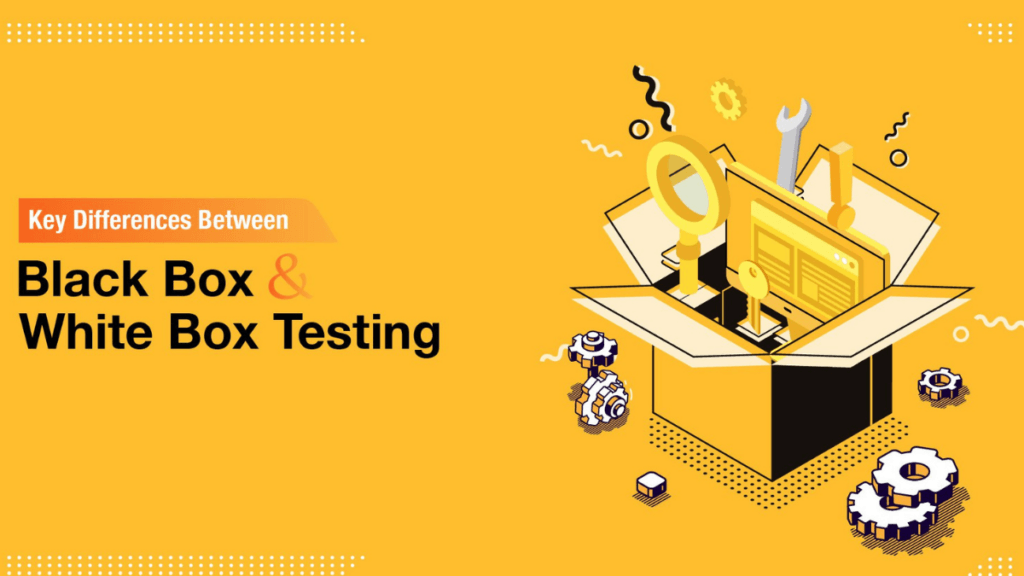
Introduction
Software testing is a critical aspect of the software development lifecycle that ensures the quality, reliability, and security of the product. Testing methodologies play a pivotal role in detecting and resolving defects, thus enhancing the overall user experience. Two prominent testing methodologies used in the industry are Black Box Testing and White Box Testing. Both approaches have their unique strengths and weaknesses, and selecting the right one for a specific project is crucial. This article aims to provide a comprehensive understanding of Black Box and White Box Testing, their differences, benefits, and scenarios where each approach excels, enabling you to make an informed decision about which approach to use in your software testing endeavors. To learn about software testing tools “enroll now at the Best Software Testing course in Kolkata, Delhi, Noida, Lucknow, Kanpur etc. to gain hands-on experience with various testing tools and enhance your testing skills.
Black Box Testing:
Black Box Testing is a functional testing technique where testers evaluate the software’s behavior without examining its internal code or structure. Testers approach the software as an external user, interacting with the application through the user interface, APIs, or other specified inputs. The primary focus of Black Box Testing is to verify if the software meets its specified requirements and functions as intended.
Advantages of Black Box Testing:
- Unbiased Testing: Since Black Box testers have no knowledge of the internal implementation details, they can identify issues solely based on the software’s intended behavior. This approach helps in uncovering potential user-centric issues, making it a valuable method for validating user experience.
- Efficient Testing: Black Box Testing allows testers to focus on the software’s functionality without concerning themselves with the internal complexities. This streamlines the testing process and often leads to quicker identification of defects.
- Independent Testing: Since Black Box testers operate independently of the development team, they provide an objective perspective on the software’s functionality. This independence ensures an unbiased evaluation of the application’s capabilities.
- Requirement Validation: Black Box Testing is highly effective in verifying whether the software adheres to the specified requirements. By checking if the application performs as intended, testers ensure that the software aligns with the clients’ expectations.
- Security Testing: As Black Box Testing assesses the software externally, it can help identify potential security vulnerabilities and loopholes that malicious users could exploit.
- User-Centric Approach: Black Box Testing revolves around user scenarios and real-life use cases, making it an excellent choice for ensuring a positive end-user experience.
Limitations of Black Box Testing:
- Incomplete Test Coverage: Black Box Testing might not explore all possible code paths or uncover deep-seated defects, as it only examines the software’s functional behavior.
- Limited Control: Testers have no control over the software’s internal workings, making it challenging to simulate specific scenarios or trace defects to their root cause.
- Redundant Test Cases: In some cases, testers might unknowingly create test cases that overlap, leading to inefficient testing and wasting resources.
- Time-Consuming: As Black Box Testing focuses on the software’s end-to-end functionality, it might require more time to design test cases and execute them thoroughly.
White Box Testing:
White Box Testing, also known as Structural Testing or Code-Based Testing, involves examining the internal structure, design, and implementation of the software. Testers have access to the source code and use this knowledge to design test cases that evaluate the code’s logic and decision-making processes. The main goal of White Box Testing is to ensure that the code functions correctly and efficiently.
Advantages of White Box Testing:
- Comprehensive Test Coverage: White Box Testing allows testers to delve deep into the software’s codebase, facilitating the identification of intricate bugs and vulnerabilities.
- Improved Code Quality: By closely scrutinizing the code, White Box Testing helps identify coding errors, potential bottlenecks, and suboptimal algorithms, leading to better code quality.
- Early Defect Detection: Since White Box Testing is typically performed during the development phase, it aids in the early detection and resolution of defects, minimizing the cost of fixing issues later in the development cycle.
- Thorough Path Coverage: Testers can ensure that all possible code paths, branches, and conditions are exercised, resulting in better code reliability.
- Performance Optimization: White Box Testing enables testers to identify areas of the code that consume excessive resources, allowing developers to optimize performance.
- Integration Testing: White Box Testing is well-suited for integration testing, ensuring that different components of the software work harmoniously.
Limitations of White Box Testing:
- Time-Consuming: Examining the internal code requires time and effort, which can extend the testing process, especially for large-scale projects.
- Code Dependency: Testers need to update test cases when code changes occur, which can be cumbersome and lead to maintenance challenges.
- Technical Expertise: Testers performing White Box Testing must possess a strong understanding of programming languages and development processes.
Incomplete User Scenario Testing: White Box Testing might focus on code functionality but may overlook real-life user scenarios that Black Box Testing emphasizes.
Choosing the Right Approach:
Selecting the appropriate testing approach depends on several factors, including project requirements, resources, timelines, and testing objectives. Here are some scenarios where each testing approach excels:
3.1. Black Box Testing:
- User-Centric Applications: If the primary objective is to ensure that the software meets end-users’ expectations and provides a satisfactory user experience, Black Box Testing is the preferred approach.
- Acceptance Testing: Black Box Testing is well-suited for acceptance testing, where the primary focus is on validating whether the software satisfies the agreed-upon requirements.
- Accessibility and Usability Testing: When evaluating applications for accessibility and usability, Black Box Testing helps ensure that the software is user-friendly and accessible to a broad audience.
- Security Testing: As Black Box Testing examines the software from an external perspective, it is valuable for detecting security vulnerabilities and potential breaches.
3.2. White Box Testing:
- Complex Algorithms: If the software contains complex algorithms, intricate logic, or critical decision-making processes, White Box Testing is essential to validate the code’s correctness and efficiency.
- Critical Applications: For mission-critical applications, such as those used in healthcare, aviation, or finance, White Box Testing is indispensable to ensure robustness and reliability.
- Integration Testing: White Box Testing is ideal for integration testing, as it helps ensure seamless communication and collaboration between different software components.
- Performance Optimization: To enhance the software’s performance and identify resource-intensive code segments, White Box Testing is the preferred choice.
- Code Review and Maintainability: When the focus is on code quality and maintainability, White Box Testing helps identify areas that need refactoring or improvement.
Conclusion
In conclusion, both Black Box Testing and White Box Testing are valuable methodologies that serve distinct purposes in the software testing landscape. The choice between the two approaches depends on the project’s specific needs, objectives, and constraints. Black Box Testing is ideal for validating user scenarios, acceptance testing, and security testing, while White Box Testing excels in assessing complex algorithms, code performance, and integration. In many cases, a combination of both approaches, often referred to as Gray Box Testing, provides comprehensive test coverage, delivering a well-rounded evaluation of the software


